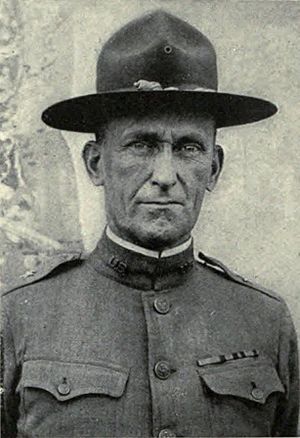Frederick B. Shaw facts for kids
Quick facts for kids
Frederick B. Shaw
|
|
|---|---|

Shaw in uniform, ca. 1918
|
|
| Birth name | Frederick Benjamin Shaw |
| Born | June 24, 1869 Burlington, Pennsylvania, U.S. |
| Died | March 1, 1957 (aged 87) Washington, D.C., U.S. |
| Buried | (38°52′45.1″N 77°04′19.8″W / 38.879194°N 77.072167°W) |
| Allegiance | |
| Service/ |
|
| Years of service | 1892–1933 |
| Rank | |
| Commands held |
|
| Battles/wars | |
Frederick B. Shaw (born June 24, 1869 – died March 1, 1957) was an important officer in the United States Army. He fought in several wars, including the Spanish–American War, the Philippine–American War, the Pancho Villa Expedition, and World War I. He became a brigadier general. He is best known for leading the 162d Depot Brigade and the 36th Infantry Brigade.
Contents
Early Life and Military Start
Frederick Benjamin Shaw was born in Burlington, Pennsylvania on June 24, 1869. His parents were Charles David and Mary Helen Shaw. He grew up in Smithfield Township, Pennsylvania and Elmira, New York. For a while, he worked as a schoolteacher. He also wrote and edited for newspapers in Chemung County. He joined the New York National Guard before joining the regular army.
In 1892, Shaw decided to become a full-time soldier. He joined the United States Army as a private in November 1892. He was part of the 21st Infantry. After three years, he became a corporal. In 1896, he passed a test to become an officer. He was made a second lieutenant in the Infantry. His first assignment was with the 5th Infantry Regiment in Fort McPherson, Georgia.
Serving in the Spanish-American War
When the Spanish–American War began in 1898, Shaw's 5th Infantry Regiment guarded ports in South Carolina. Later, they moved to Tampa, Florida. Shaw became a quartermaster and commissary officer for a special brigade. This meant he was in charge of supplies and food.
His brigade then went to Puerto Rico. Shaw fought in the campaign there, including a battle at Hormigueros. After the war, he served in Cuba. He learned he had been promoted to first lieutenant. He was assigned to the 19th Infantry Regiment in Puerto Rico. This new regiment was then sent to the Philippines. Shaw served there from 1899 to 1901. He took part in the 1899-1900 campaign on Panay island during the Philippine Insurrection.
Between the Big Wars
In 1901, Shaw became a captain. He served with the 30th Infantry Regiment in different places. He also helped inspect the Arkansas National Guard. In 1906, he finished a special training course at Fort Leavenworth, Kansas. This school is now called the Command and General Staff College.
From 1908 to 1909, Shaw was with the 30th Infantry in Manila, Philippines. After returning to the U.S., he helped with army recruiting. He later rejoined his regiment in San Diego. In 1912, he moved to the 8th Infantry and served again in the Philippines. In 1914, he was in charge of Fort Brady, Michigan. In 1916, he was back with the 30th Infantry in New York.
World War I Service
In July 1916, Shaw was promoted to major. He joined the 36th Infantry. This regiment worked along the Texas-Mexico border during the Mexican Expedition. When World War I started, the 36th Infantry moved to Fort Snelling, Minnesota. Some of its experienced soldiers helped form new regiments.
Shaw became a temporary colonel in August 1917. He worked as the chief of staff for the 87th Division in Arkansas. Later, he commanded the 162d Depot Brigade. He also led the 2nd Replacement Brigade at Fort Gordon, Georgia.
In October 1918, Shaw was promoted to temporary brigadier general. He commanded the 36th Infantry Brigade, part of the 18th Division in Texas. He sometimes acted as the division commander. The war ended in November 1918, so the 18th Division was not needed for combat. It was closed down in February 1919.
After World War I
In February 1919, Shaw returned to his permanent rank of major. He became the head of Army recruiting for the Northeastern District in Boston. He was promoted to lieutenant colonel in January 1920, and then to colonel in July. In 1921, he completed another training course at Fort Benning, Georgia.
He then served with the 37th Infantry Regiment in Fort Wayne, Michigan. Later that year, he became a senior instructor for the West Virginia National Guard. In 1923, he worked with National Guard affairs for the Fifth Corps Area in Fort Benjamin Harrison, Indiana.
In 1926, he worked on training for the Militia Bureau. In 1928, he commanded the 2nd Infantry at Fort Sheridan, Illinois. From 1930, Shaw was a senior instructor for the Kentucky and Indiana National Guards.
Retirement and Legacy
Shaw retired from the Army on June 30, 1933, at age 64. A law from 1930 allowed World War I generals to retire at their highest wartime rank. So, Shaw was promoted to brigadier general on the Army's retired list. He lived in Arlington, Virginia.
Frederick B. Shaw passed away in Washington, D.C., on March 1, 1957. His funeral was at the Fort Myer chapel. He was buried at Arlington National Cemetery.
Shaw wrote two books. One was about the history of the Second Infantry, U.S. Army (1930). The other was about the history of the Shaw family (1942). He was a member of The Society of the Cincinnati, an organization for descendants of officers who served in the American Revolution. He was also a Mason and a member of the Military Order of the Carabao.
Family Life
In 1908, Shaw married Mary Davis (Bell) Macfarlane (1879-1946). Mary had a daughter from her first marriage, Marion Macfarlane. Marion later married Army major general Howard L. Peckham. Frederick and Mary Shaw had four children together: Helen Barbara, Frederick Benjamin Jr., Robert Champlain, and Daniel Joseph. In 1950, Shaw married Winifred F. Rankin (1888-1966).

